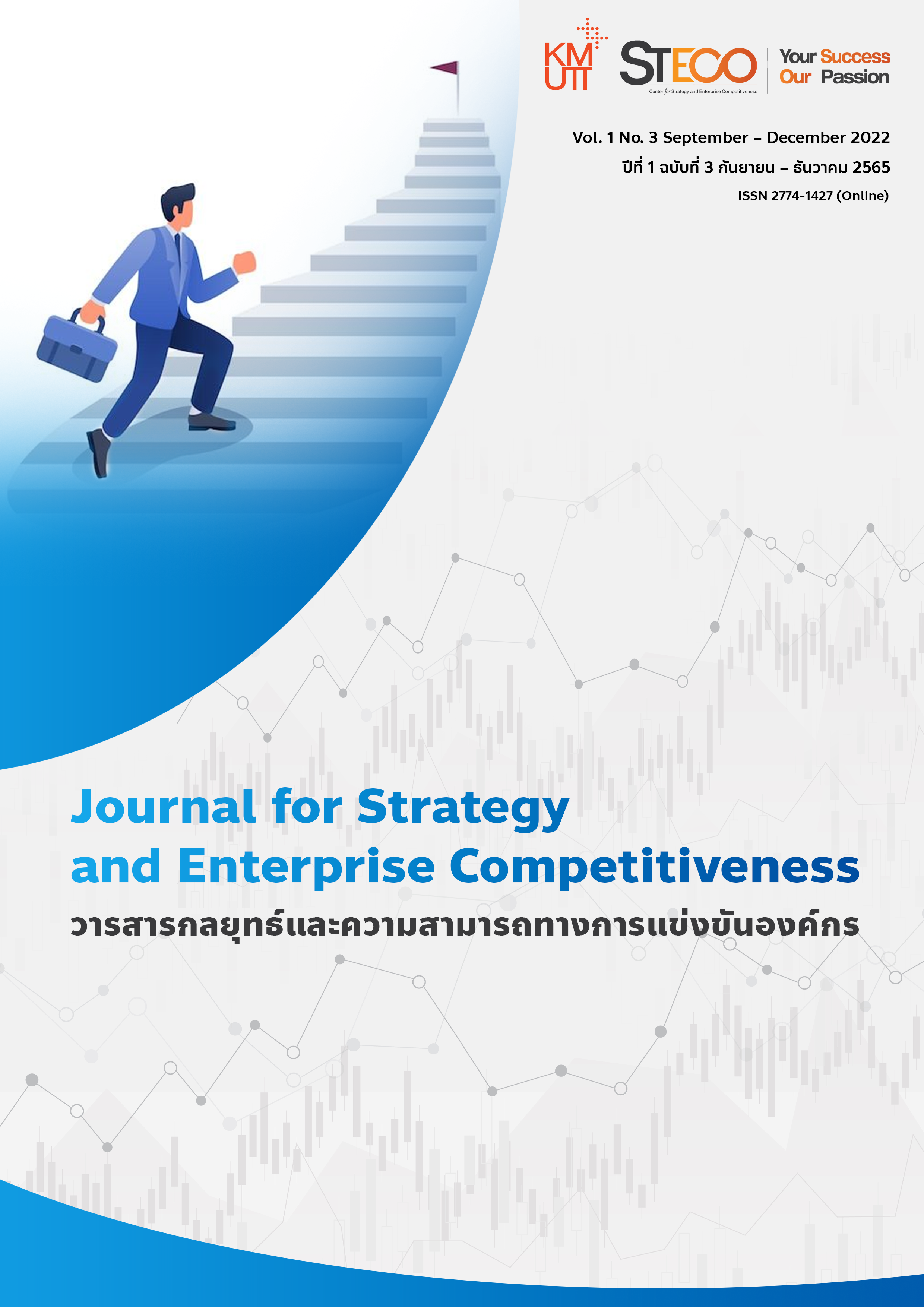การบูรณาการโซ่อุปทาน ความได้เปรียบในการแข่งขัน และผลการดำเนินงานของผู้ประกอบการผ้าไหมทอมือ
คำสำคัญ:
การบูรณาการโซ่อุปทาน, ความได้เปรียบในการแข่งขัน, ผลการดำเนินงาน, ผู้ประกอบการผ้าไหมทอมือบทคัดย่อ
การวิจัยนี้มีวัตถุประสงค์เพื่อศึกษาอิทธิพลของการบูรณาการโซ่อุปทานที่มีผลต่อความได้เปรียบในการแข่งขัน และอิทธิพลของการบูรณาการโซ่อุปทานและความได้เปรียบในการแข่งขันที่มีผลต่อผลการดำเนินงาน โดยรวบรวมข้อมูลจากผู้ประกอบการผ้าไหมทอมือที่ได้รับการรับรองคุณภาพผลิตภัณฑ์ชุมชนในภาคตะวันออกเฉียงเหนือตอนล่าง 1 (นครชัยบุรินทร์) จำนวน 238 รายในช่วงสถานการณ์ COVID-19 แล้ววิเคราะห์ข้อมูลด้วยสถิติเชิงพรรณนา และสถิติเชิงอนุมาน ซึ่งผลการวิจัยพบว่า ผู้ประกอบการผ้าไหมทอมือมีการบูรณาการโซ่อุปทานในระดับปานกลาง มีความได้เปรียบในการแข่งขันด้านคุณภาพในระดับสูง และความได้เปรียบในการแข่งขันด้านต้นทุนในระดับปานกลาง แต่มีผลการดำเนินงานในระดับต่ำ นอกจากนี้ยังพบว่า การบูรณาการโซ่อุปทานภายในช่วยเพิ่มความได้เปรียบในการแข่งขันด้านต้นทุน การบูรณาการกับลูกค้าช่วยเพิ่มความได้เปรียบด้านคุณภาพ ส่วนความได้เปรียบในการแข่งขันด้านต้นทุนและคุณภาพช่วยเพิ่มผลสำเร็จของการดำเนินงานอย่างมีนัยสำคัญทางสถิติ แต่การบูรณาการกับซัพพลายเออร์ไม่มีผลต่อความได้เปรียบในการแข่งขันและผลการดำเนินงานของผู้ประกอบการผ้าไหมทอมือ
References
Abeysekara, N., Wang, H., and Kuruppuarachchi, D. (2019). Effect of supply-chain resilience on firm performance and competitive advantage. Business Process Management Journal, 25(7), 1673-1695.
Alfalla-Luque, R., Machuca, J. A. D., and Marin-Garcia, J. A. (2018). Triple-A and competitive advantage in supply chains: Empirical research in developed countries. International Journal of Production Economics, 203, 48-61.
Alfalla-Luque, R., Marin-Garcia, J. A., and Medina-Lopez, C. (2015). An analysis of the direct and mediated effects of employee commitment and supply chain integration on organisational performance. International Journal of Production Economics, 162, 242-257.
Amoako-Gyampah, K., Boakye, K. G., Adaku, E., and Famiyeh, S. (2019). Supplier relationship management and firm performance in developing economies: A moderated mediation analysis of flexibility capability and ownership structure. International Journal of Production Economics, 208, 160-170.
Andersén, J. (2021). A Relational Natural-Resource-based View on Product Innovation: The Influence of Green Product Innovation and Green Suppliers on Differentiation Advantage in Small Manufacturing Firms. Technovation, 104, 102254.
Baah, C., and Jin, Z. (2019). Sustainable Supply Chain Management and Organizational Performance: The Intermediary Role of Competitive Advantage. Journal of Management and Sustainability, 9(1), 119-131.
Bastas, A., and Liyanage, K. (2019). Integrated quality and supply chain management business diagnostics for organizational sustainability improvement. Sustainable Production and Consumption, 17, 11-30.
Chahal, H., Gupta, M., Bhan, N., and Cheng, T. C. E. (2020). Operations management research grounded in the resource-based view: A meta-analysis. International Journal of Production Economics, 230, 1-16.
Chang, W., Ellinger, A. E., Kim, K., and Franke, G. R. (2016). Supply chain integration and firm financial performance: A meta-analysis of positional advantage mediation and moderating factors. European Management Journal, 34(3), 282-295.
Chen, C. J. (2018). Developing a model for supply chain agility and innovativeness to enhance firms’ competitive advantage. Management Decision, 57(7), 1511-1534.
Department of International Trade Promotion. (2021). Home Textile Products. Retrieved from https://www.ditp.go.th/contents_attach/722091/722091.pdf
Donkor, F., Papadopoulos, T., and Spiegler, V. (2021). The supply chain integration – Supply chain sustainability relationship in the UK and Ghana pharmaceutical industry: A stakeholder and contingency perspective. Transportation Research Part E: Logistics and Transportation Review, 155, 102477.
Equitable Education Fund. (2021). Stand With the "Capital" of the Community. Retrieved from https://www.eef.or.th/article-stand-with-the-capital-of-the-community/
Hair, J. J., Black, W., Babin, B., and Anderson, R. (2010). Multivariate Data Analysis (7th Edition). New Jersey: Pearson.
Haseeb, M., Hussain, H. I., Kot, S., Androniceanu, A., and Jermsittiparsert, K. (2019). Role of Social and Technological Challenges in Achieving a Sustainable Competitive Advantage and Sustainable Business Performance. Sustainability, 11(14), 3811.
Huo, B., Zhao, X., and Lai, F. (2014). Supply Chain Quality Integration: Antecedents and Consequences. IEEE Transactions on Engineering Management, 61(1), 38-51.
Kamble, S. S., Gunasekaran, A., and Gawankar, S. A. (2020). Achieving sustainable performance in a data-driven agriculture supply chain: A review for research and applications. International Journal of Production Economics, 219, 179-194.
Lower Northeastern Province Group 1. (2021). Follow-up Results of the Project Performance According to the Annual Government Action Plan of the Lower Northeastern Provinces Group 1 for Fiscal Year 2021. Retrieved from http://www.osmnortheast-s1.moi.go.th/file/report_content/1657509178.pdf
Ministry of Commerce. (2022). Major Export Markets of Thailand by Product. Retrieved from https://tradereport.moc.go.th/Report/Default.aspx?Report=MenucomTopNRecode&Option=3&Lang=Th&ImExType=1
Munir, M., Jajja, M. S. S., Chatha, K. A., and Farooq, S. (2020). Supply chain risk management and operational performance: The enabling role of supply chain integration. International Journal of Production Economics, 227, 1-14.
Puspita, L. E., Christiananta, B., and Ellitan, L. (2020). The Effect of Strategic Orientation, Supply Chain Capability, Innovation Capability, on Competitive Advantage, and Performance of Furniture Retails. International Journal of Scientific & Technology Research, 9(03), 4521-4529.
Rovinelli, R. J., and Hambleton, R. K. (1977). On the Use of Content Specialists in the Assessment of Criterion-referenced Test Item Validity. Dutch Journal of Educational Research, 2(2), 49-60.
Shibin, K. T., Gunasekaran, A., and Dubey, R. (2017). Explaining sustainable supply chain performance using a total interpretive structural modeling approach. Sustainable Production and Consumption, 12, 104-118.
Shukor, A. A. A., Newaz, M. S., Rahman, M. K., and Taha, A. Z. (2021). Supply chain integration and its impact on supply chain agility and organizational flexibility in manufacturing firms. International Journal of Emerging Markets, 16(8), 1721-1744.
Tavakol, M., and Dennick, R. (2011). Making Sense of Cronbach's alpha. Int J Med Educ, 2, 53-55.
Thai Community Product Standards. (2021). List of Producers by North East Region. Retrieved from https://tcps.tisi.go.th/public/en/certificatemap.aspx?region=3®ionname=North+East
Thailand Plus Online. (2019). Ministry of Commerce Supports Thai Silk Market by Organizing Silk Road to Thai way of Tourism Northeast. Retrieved from https://www.thailandplus.tv/archives/62854
Tukamuhabwa, B., Mutebi, H., and Kyomuhendo, R. (2021). Competitive Advantage in SMEs: Effect of Supply Chain Management Practices, Logistics Capabilities and Logistics Integration in a Developing Country. Journal of Business and Socio-economic Development.
Yamane, T. (1973). Statistics. An introductory analysis. (3rd Edition). New York: Harper & Row.
Yuen, K. F., and Thai, V. V. (2017). The influence of supply chain integration on operational performance. The International Journal of Logistics Management, 28(2), 444-463.
Zhang, M., Guo, H., Huo, B., Zhao, X., and Huang, J. (2019). Linking supply chain quality integration with mass customization and product modularity. International Journal of Production Economics, 207, 227-235.
Zhao, L., Huo, B., Sun, L., and Zhao, X. (2013). The Impact of Supply Chain Risk on Supply Chain Integration and Company Performance: a Global Investigation. Supply Chain Management: An International Journal, 18(2), 115-131.
Downloads
เผยแพร่แล้ว
How to Cite
ฉบับ
บท
License
Copyright (c) 2022 วารสารกลยุทธ์และความสามารถทางการแข่งขันองค์กร

This work is licensed under a Creative Commons Attribution-NonCommercial-NoDerivatives 4.0 International License.
ข้อคิดเห็นที่ปรากฏและแสดงในเนื้อหาบทความต่าง ๆ ในวารสารกลยุทธ์และความสามารถทางการแข่งขันองค์กร ถือเป็นความเห็นและความรับผิดชอบโดยตรงของผู้เขียนบทความนั้น ๆ มิใช่เป็นความเห็นและความรับผิดชอบใด ๆ ของศูนย์กลยุทธ์และความสามารถทางการแข่งขันองค์กร มหาวิทยาลัยเทคโนโลยีพระจอมเกล้าธนบุรี
บทความ ข้อมูล เนื้อหา และรูปภาพ ฯลฯ ในวารสารกลยุทธ์และความสามารถทางการแข่งขันองค์กร ถือเป็นลิขสิทธิ์เฉพาะของศูนย์กลยุทธ์และความสามารถทางการแข่งขันองค์กร มหาวิทยาลัยเทคโนโลยีพระจอมเกล้าธนบุรี หากบุคคลหรือหน่วยงานใดต้องการนำทั้งหมดหรือส่วนหนึ่งส่วนใดไปเผยแพร่ต่อหรือเพื่อกระทำการใด ๆ จะต้องได้รับอนุญาตเป็นลายลักษณ์อักษรจากศูนย์กลยุทธ์และความสามารถทางการแข่งขันองค์กร มหาวิทยาลัยเทคโนโลยีพระจอมเกล้าธนบุรีก่อนเท่านั้น


